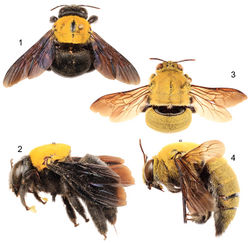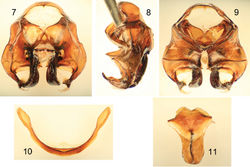Xylocopa aestuans
| Notice: | This page is derived from the original publication listed below, whose author(s) should always be credited. Further contributors may edit and improve the content of this page and, consequently, need to be credited as well (see page history). Any assessment of factual correctness requires a careful review of the original article as well as of subsequent contributions.
If you are uncertain whether your planned contribution is correct or not, we suggest that you use the associated discussion page instead of editing the page directly. This page should be cited as follows (rationale):
Citation formats to copy and paste
BibTeX: @article{Hannan2012ZooKeys201, RIS/ Endnote: TY - JOUR Wikipedia/ Citizendium: <ref name="Hannan2012ZooKeys201">{{Citation See also the citation download page at the journal. |
Ordo: Hymenoptera
Familia: Apidae
Genus: Xylocopa
Name
Xylocopa aestuans (Linnaeus) – Wikispecies link – Pensoft Profile
- Apis aestuans Linnaeus, 1758: 579 [♀].
- Xylocopa aestuans (Linnaeus); Illiger 1806[1]: 151.
Diagnosis
Xylocopa aestuans can be most readily distinguished from other Saudi Arabian large carpenter bees by the following: female face with largely white or pale pubescence (Fig. 5), mesosomal dorsum densely covered by yellow pubescence obscuring underlying integument (Figs 1, 2); mandible bidentate at apex; posterodorsal margin of mesoscutellum projecting beyond posterior margin of metanotum; pygidial plate unarmed. Male covered by dense yellow pubescence (Figs 3, 4, 6); first metasomal tergum with subhorizontal dorsal surface abruptly and angulately separated from declivitous anterior surface; gradulus of first metasomal tergum transverse, lateral extremities not directed posteriorly; male terminalia as in figures 7–11.
Comments
Xylocopa aestuans is one of the widespread and ubiquitous of large carpenter bee species. There has been considerable debate regarding the identity of the species of Koptortosoma similar to Xylocopa aestuans (i.e., considering them synonyms, subspecies, or separate species), with different authors of varying opinions how to segregate the minor variation into natural taxonomic entities (e.g., Lieftinck 1964[2]). The Saudi Arabian populations have been at times considered to the belong to the largely African, Xylocopa pubescens Spinola, although the genitalia of those populations are quite dissimilar from true Xylocopa pubescens. Indeed, the genitalia (Figs. 7–11) and other characters are certainly more alike the more easterly populations of Xylocopa aestuans and there seems little reason at this time to not consider the central Saudi Arabian populations as such, as was done by Shalaby (1961)[3]. The species has also been recorded from the United Arab Emirates (Harten 2005[4]; Dathe 2009[5]). Biological accounts, largely from India or Southeast Asia, have been provided by Dover (1924)[6], Monod (1977)[7], Binti (1992)[8], El-Borollosy and Ismail (1972[9]: note that these observations may be of Xylocopa pubescens, the identity of their material requires checking), and Punekar et al. (2010)[10].
Taxon Treatment
- Hannan, M; Alqarni, A; Owayss, A; Engel, M; 2012: The large carpenter bees of central Saudi Arabia, with notes on the biology of Xylocopa sulcatipes Maa (Hymenoptera, Apidae, Xylocopinae) ZooKeys, 201: 1-14. doi
Other References
- ↑ Illiger K (1806) William Kirby’s Familien der Bienenartigen Insekten mit Zusätzen, Nachweisungen und Bemerkungen. Magazin für Insektenkunde 5: 28-175.
- ↑ Lieftinck M (1964) The identity of Apis aestuans Linné, 1758, and related Old World carpenter-bees (Xylocopa Latr.). Tijdschrift voor Entomologie 107 (3): 137-158.
- ↑ Shalaby F (1961) A preliminary survey of the insect fauna of Saudi Arabia. Bulletin de la Société Entomologique d’Égypte 45: 211-228.
- ↑ van Harten A (2005) The Insects of the United Arab Emirates: A Checklist of Published Records. Dar Al Ummah, Abu Dhabi, UAE, 86 pp.
- ↑ Dathe H (2009) Order Hymenoptera, superfamily Apoidea: Families Colletidae, Andrenidae, Halictidae, Melittidae, Megachilidae and Apidae. Arthropod Fauna of the UAE 2: 335-432.
- ↑ Dover C (1924) Some observations on the bionomics of Xylocopa aestuans Linn. (Apidae). Transactions of the Royal Entomological Society of London 72(1/2): 144-149. doi: 10.1111/j.1365-2311.1924.tb03354.x
- ↑ Monod T (1977) Percement de la fleur de Tecoma stans (L.) par Xylocopa aestuans (L.) à Nouakchott (Mauritanie). Bulletin de l’Institut Fondamental d’Afrique Noire, Série A, Sciences Naturelles 39 (1): 169-176.
- ↑ Binti I (1992) Foraging and nesting behaviour of carpenter bee, Xylocopa aestuans. Malaysian Applied Biology 21 (2): 85-91.
- ↑ El-Borollosy F, Ismail M (1972) Nesting habits and flight behaviour of Xylocopa aestuans L. (Hymenoptera: Apidae). Bulletin de la Société Entomologique d’Égypte 56: 399-405.
- ↑ Punekar S, Kumaran N, Bhat H (2010) Observations on an unusual behaviour in the carpenter bee Xylocopa aestuans (Latreille, 1802) (Hymenoptera: Apidae) of the Western Ghats, India. Journal of Threatened Taxa 2 (10): 1232-1233.
Images
|


